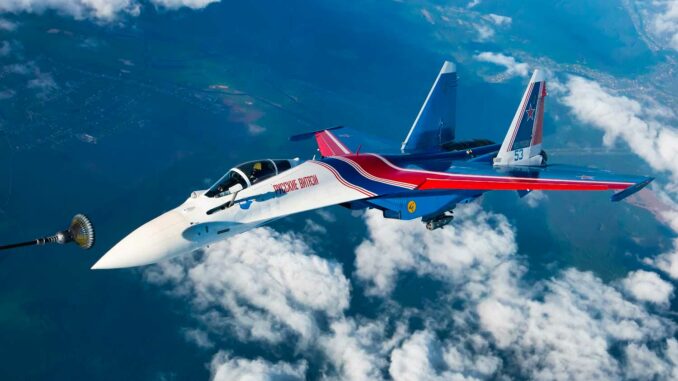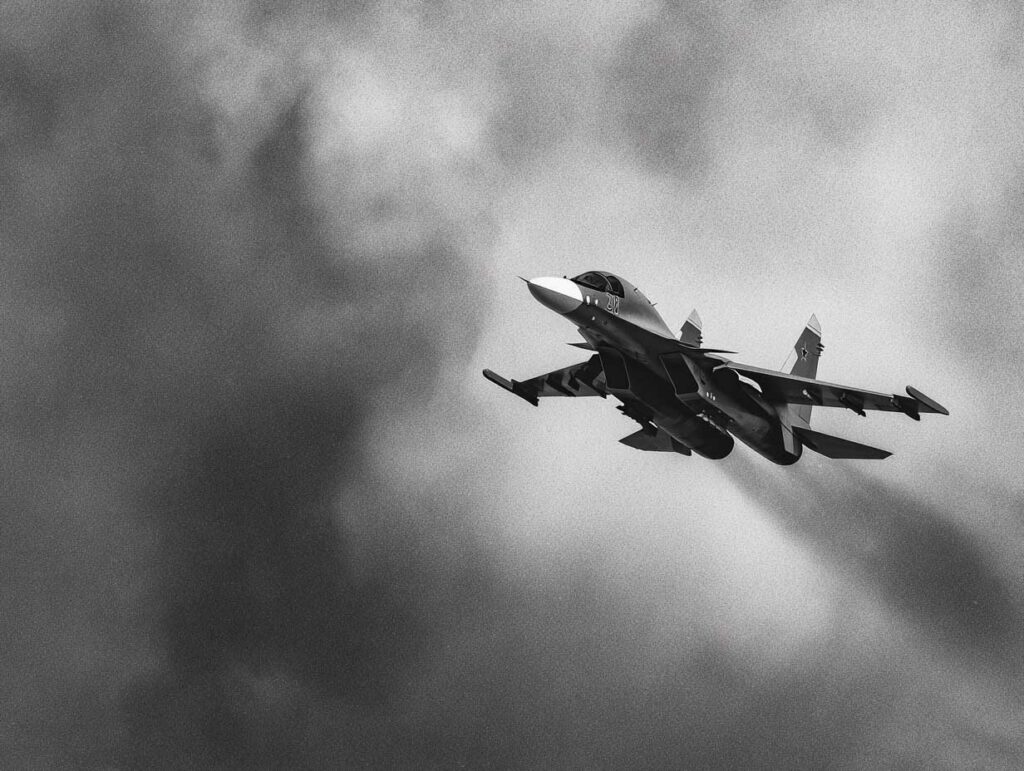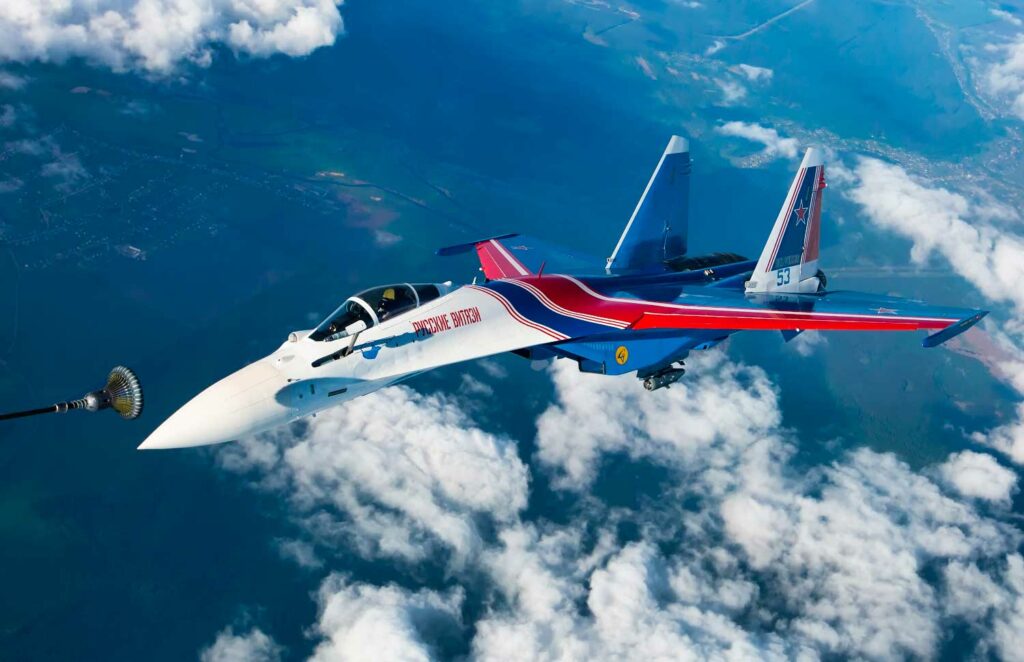
An investigation reveals that Russian Su-34 and Su-35 aircraft, used against civilians in Ukraine, contain hundreds of microelectronic components from Western countries.
A report published in June 2025 shows that Russian Su-34 and Su-35 aircraft involved in air strikes against Ukrainian civilian targets contain large quantities of Western electronic components. The investigation identified 1,115 components from 141 global manufacturers, including Texas Instruments, Intel, Murata, and Analog Devices. These integrated circuits, capacitors, and power modules are essential for guidance, navigation, communication, and targeting functions. Despite sanctions, these components are reaching Russia via opaque logistics circuits passing through China, Turkey, the United Arab Emirates, and European shell companies. The report questions industrial responsibility and the effectiveness of export control mechanisms. It also warns that this technical dependence does not prevent the use of these aerial platforms in the conflict, particularly against civilians.

Structural dependence on foreign microelectronic components
The Su-34 and Su-35 fighter jets, designed by Sukhoi, form the backbone of the Russian Federation’s long-range air strike capabilities. These two multi-role aircraft, derived from the same chassis, are equipped to deliver guided munitions, carry out precision strikes and operate in highly contested environments. Their onboard technology relies heavily on imported electronics.
The investigation conducted by the IPHR (International Partnership for Human Rights) and NAKO (Independent Anti-Corruption Commission in Ukraine) reveals that the most modern versions of these aircraft contain hundreds of Western-made electronic components. Investigators have identified 1,115 microelectronic modules on downed aircraft, originating from 141 different manufacturers, mainly American, German, Japanese, South Korean, and Taiwanese.
These components perform critical functions: power regulation, target acquisition, inertial navigation, radar signal processing, tactical communications, and munitions guidance systems. These include integrated circuits, voltage regulators, specialized microprocessors, and sensors. These miniaturized components cannot be produced on a large scale in Russia within a timeframe compatible with current military requirements.
The Su-34, a two-seat ground attack aircraft, uses these modules to coordinate munitions such as the UMPB D30-SN and Grom-1, both of which are equipped with assisted guidance. The Su-35, meanwhile, uses this electronics to manage its active antenna radars and infrared sensors integrated into its warning system.
Opaque logistics enable supplies to reach Russia
The logistics channels identified in the report enable Moscow to circumvent export sanctions imposed in 2014 and reinforced in 2022. In 2023, more than 180,000 deliveries of sensitive components entered Russian territory, with a total estimated value of $740 million.
These flows pass through intermediary countries: China is the main hub, but re-shipments also take place via Hong Kong, Turkey, the United Arab Emirates, and several unspecified European countries. Russian companies use front companies, sometimes based in countries that are tolerant or uncooperative when it comes to export controls.
Some suppliers make no secret of their strategy. Russian websites specializing in electronics publicly advertise their ability to procure circuits from brands such as Texas Instruments, Vicor, OnSemi, and Maxim. The report also identifies brokers active in the import of civilian semiconductors converted for military use.
There are numerous mechanisms for document fraud, including reclassifying components as civilian goods, changing the country of origin, and using false certificates of final destination. The complexity of supply chains prevents real-time monitoring, even in countries with structured regulatory agencies.
Air strikes deliberately targeting civilians
The use of Su-34 and Su-35 aircraft in the Ukrainian conflict has led to repeated strikes on civilian infrastructure, as documented by the investigation covering the period May 2023 to May 2024. Analysts have identified more than 60 confirmed strikes, causing 26 deaths and 109 civilian injuries, as well as the destruction of 71 homes, 5 schools, 5 hospitals, and several energy infrastructure facilities.
A particularly striking example is the strike on May 25, 2024, in Kharkiv. A Russian Su-34 dropped two UMPB D30-SN bombs on an Epicentr hypermarket. The attack killed 19 civilians and injured 54 others. No military targets were identified in the area. Debris from the munitions and videos of the impact enabled precise geolocation and identification of the weapons used.
This type of mission relies on precise on-board electronic guidance. Without the microcomponents mentioned, coordinating this type of munition would be difficult, if not impossible. The investigation therefore establishes a direct link between the presence of Western components and Russia’s technical capability to target urban targets.
The Russian authorities’ argument that this was a military headquarters has been refuted by cartographic records and the absence of military structures in the vicinity. Residents interviewed confirm that the impact was concentrated in a purely civilian area.

Industrial and political responsibility called into question
The report does not conclude that there was a deliberate violation of sanctions by the manufacturers. However, it does criticize a lack of due diligence in monitoring supply chains. The question raised is an ethical one: what can and should a company do to prevent its components from being used in weapons systems targeting civilians?
Some companies, particularly in the semiconductor sector, have not implemented full traceability beyond the first-tier distributor. This allows dual-use (military/civilian) components to change use without triggering an internal alert. The lack of terminal control over final destinations exacerbates the problem.
Western governments are also being criticized for their delay in closing regulatory loopholes. Despite the adoption of specific sanctions regimes, extraterritorial control mechanisms remain inadequate, particularly with regard to indirect exports.
The report calls on states to prosecute intermediaries, including in partner countries. It also proposes the creation of lists of components for critical use in military aviation, accompanied by continuous tracking, based on the model for exports of sensitive nuclear materials.
A persistent threat to European security
Keeping Su-34 and Su-35 fighter jets in operation thanks to Western electronic components is a strategic challenge for European countries and the United States. As long as these flows are not controlled, Russia will be able to sustain its long-range strike effort against Ukrainian cities.
Analysis of wreckage shows that non-Russian critical components still account for the majority of onboard electronic systems. This limits the effectiveness of sanctions, which are circumvented by parallel commercial networks.
In the longer term, these revelations undermine international efforts to control sensitive technologies at a time when dual-use technologies are becoming the norm. Commoditized microprocessors are now at the heart of complex lethal systems, requiring a review of export and certification rules.
Finally, the report calls for these issues to be incorporated into intergovernmental discussions on export controls, including in multilateral forums such as the Wassenaar Arrangement, in order to reduce the accessibility of critical technologies to regimes under sanctions.
War Wings Daily is an independant magazine.